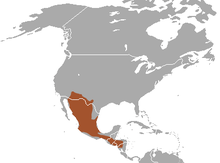Hooded skunk
The hooded skunk (Mephitis macroura) is a species of mammal in the family Mephitidae. Mephītis in Latin means "foul odor", μακρός (makrós) in Greek translates to "long" and οὐρά (ourá) translates to "tail".
| Hooded skunk | |
|---|---|
 | |
| Scientific classification | |
| Kingdom: | Animalia |
| Phylum: | Chordata |
| Class: | Mammalia |
| Order: | Carnivora |
| Family: | Mephitidae |
| Genus: | Mephitis |
| Species: | M. macroura |
| Binomial name | |
| Mephitis macroura Lichtenstein, 1832 | |
 | |
| Hooded skunk range | |
Morphology
It can be distinguished from the similar striped skunk (M. mephitis) by its longer tail and longer, much softer coat of fur, and larger tympanic bullae.[2] A ruff of white fur around its neck gives the animal its common name. Three color phases are known and in all three, a thin white medial stripe is present between the eyes: black-backed with two lateral white stripes, white-backed with one dorsal white stripe, or entirely black with a few white hairs in the tail.[3][4]
Ecology
The hooded skunk ranges from the Southwestern United States to Mexico, Guatemala, Honduras, Nicaragua, and northwest Costa Rica.[1] It is more abundant in Mexico. These skunks are found to be more than 50% smaller in size in southern Mexico than in the Southwestern United States.[5] It is found in grasslands, deserts, and in the foothills of mountains, avoiding high elevations. It tends to live near a water source, such as a river. The females tend to be 15% smaller in size than the males[6] and their breeding season is between February and March.[4] The litter size ranges from three to eight.[7]
Diet
The diet of the hooded skunk consists mostly of vegetation, especially prickly pear (Opuntia spp.), but it will readily consume insects, small vertebrates, and bird eggs [4] as well. No cases of rabies are reported,[8][9] but they host a range of parasites, including nematodes, roundworms, and fleas.[4]
Behavior
Hooded skunks are solitary, but they might interact at a feeding ground without showing any signs of aggression.[10] They shelter in a burrow or a nest of thick plant cover during the day and are active at night. Like M. mephitis, for self-defense, they spray volatile components from their anal glands.![11]
Characteristics
Hooded skunks are currently not endangered. They are very abundant in Mexico and can live in human suburban areas mostly on pastures and cultivated fields.[12] Their fur has low economic value.[7] However, their fat[11] and scent glands[10] can be used in local folk medicine. In some parts of their range, their flesh is considered a delicacy.[13] Other common names for the hooded skunk include: mofeta rayada (Spanish), moufette à capuchon (French), pay (Maya), southern skunk, white-sided skunk, and zorillo.[14]
References
- Cuarón, A.D.; Reid, F. & Helgen, K. (2008). "Mephitis macroura". IUCN Red List of Threatened Species. 2008. Retrieved 27 January 2009.CS1 maint: ref=harv (link)
- Hall, E. R. (1981). The mammals of North America (Second ed.). New York: John Wiley & Sons. pp. 601–1181.
- Hoffmeister, D. F. (1986). Mammals of Arizona. Tucson: University of Arizona Press.
- Patton, R. F. (1974). Ecological and behavioral relationships of the skunks of Trans Pecos Texas. Ph.D. dissertation. Texas A&M University. p. 199.
- Janzen, D. H. and W. Hallwachs (1982). The hooded skunk, Mephitis macroura, in lowland northwestern Costa Rica. Brenesia. pp. 19/20:549–552.
- Rosatte, R. C. (1987). Striped, spotted, hooded, and hog-nosed skunk. Toronto, Canada: Ontario Ministry of Natural Resources.
- Bailey, V. (1932). "Mammals of New Mexico". North American Fauna. 53: 1–412. doi:10.3996/nafa.53.0001.
- Aranda, M.; L. Lopez-De Buen (1999). "Rabies in skunks from Mexico". Journal of Wildlife Diseases. 35: 574–577. doi:10.7589/0090-3558-35.3.574.
- Ceballos, G., And A. Miranda (1986). Los mamiferos de Chmela, Jalisco: manual de campo. Mexico City, Mexico: Universidad Nacional Autonoma de Mexico.
- Reid, F. A. (1997). A field guide to the mammals of Central America and south east Mexico. New York: Oxford University Press.
- Dalquest, W. W. (1953). Mammals of the Mexican state of San Luis Potosi. Balton Rouge: Louisiana State University Press.
- Yeen, Ten Hwang; Serge Lariviere (26 December 2001). "Mephitis macroura". Mammalian Species. 686: 1–3. doi:10.1644/1545-1410(2001)686<0001:mm>2.0.co;2.
- Davis, W. B. (1944). "Notes on Mexican mammals". Journal of Mammalogy. 25: 370–402. doi:10.2307/1374900.
- Borror, D. J. (1960). Dictionary of word roots and combining forms. Palo Alto, California: National Press Books.
